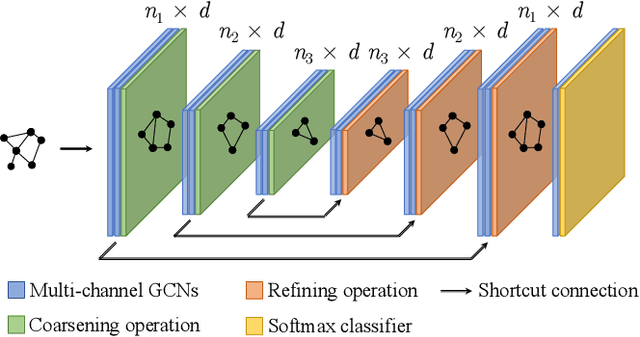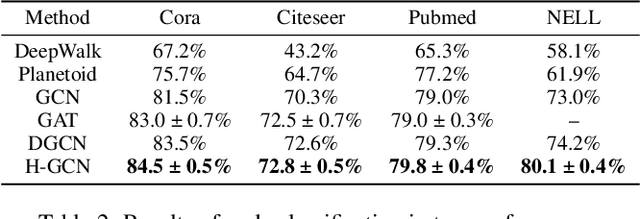Fenyu Hu
Fully Hyperbolic Graph Convolution Network for Recommendation
Aug 10, 2021



Abstract:Recently, Graph Convolution Network (GCN) based methods have achieved outstanding performance for recommendation. These methods embed users and items in Euclidean space, and perform graph convolution on user-item interaction graphs. However, real-world datasets usually exhibit tree-like hierarchical structures, which make Euclidean space less effective in capturing user-item relationship. In contrast, hyperbolic space, as a continuous analogue of a tree-graph, provides a promising alternative. In this paper, we propose a fully hyperbolic GCN model for recommendation, where all operations are performed in hyperbolic space. Utilizing the advantage of hyperbolic space, our method is able to embed users/items with less distortion and capture user-item interaction relationship more accurately. Extensive experiments on public benchmark datasets show that our method outperforms both Euclidean and hyperbolic counterparts and requires far lower embedding dimensionality to achieve comparable performance.
Label-informed Graph Structure Learning for Node Classification
Aug 10, 2021



Abstract:Graph Neural Networks (GNNs) have achieved great success among various domains. Nevertheless, most GNN methods are sensitive to the quality of graph structures. To tackle this problem, some studies exploit different graph structure learning strategies to refine the original graph structure. However, these methods only consider feature information while ignoring available label information. In this paper, we propose a novel label-informed graph structure learning framework which incorporates label information explicitly through a class transition matrix. We conduct extensive experiments on seven node classification benchmark datasets and the results show that our method outperforms or matches the state-of-the-art baselines.
Graph Classification by Mixture of Diverse Experts
Mar 29, 2021



Abstract:Graph classification is a challenging research problem in many applications across a broad range of domains. In these applications, it is very common that class distribution is imbalanced. Recently, Graph Neural Network (GNN) models have achieved superior performance on various real-world datasets. Despite their success, most of current GNN models largely overlook the important setting of imbalanced class distribution, which typically results in prediction bias towards majority classes. To alleviate the prediction bias, we propose to leverage semantic structure of dataset based on the distribution of node embedding. Specifically, we present GraphDIVE, a general framework leveraging mixture of diverse experts (i.e., graph classifiers) for imbalanced graph classification. With a divide-and-conquer principle, GraphDIVE employs a gating network to partition an imbalanced graph dataset into several subsets. Then each expert network is trained based on its corresponding subset. Experiments on real-world imbalanced graph datasets demonstrate the effectiveness of GraphDIVE.
GraphAIR: Graph Representation Learning with Neighborhood Aggregation and Interaction
Nov 14, 2019



Abstract:Graph representation learning is of paramount importance for a variety of graph analytical tasks, ranging from node classification to community detection. Recently, graph convolutional networks (GCNs) have been successfully applied for graph representation learning. These GCNs generate node representation by aggregating features from the neighborhoods, which follows the "neighborhood aggregation" scheme. In spite of having achieved promising performance on various tasks, existing GCN-based models have difficulty in well capturing complicated non-linearity of graph data. In this paper, we first theoretically prove that coefficients of the neighborhood interacting terms are relatively small in current models, which explains why GCNs barely outperforms linear models. Then, in order to better capture the complicated non-linearity of graph data, we present a novel GraphAIR framework which models the neighborhood interaction in addition to neighborhood aggregation. Comprehensive experiments conducted on benchmark tasks including node classification and link prediction using public datasets demonstrate the effectiveness of the proposed method over the state-of-the-art methods.
Semi-supervised Node Classification via Hierarchical Graph Convolutional Networks
Mar 05, 2019



Abstract:Graph convolutional networks (GCNs) have been successfully applied in node classification tasks of network mining. However, most of these models based on neighborhood aggregation are usually shallow and lack the "graph pooling" mechanism, which prevents the model from obtaining adequate global information. In order to increase the receptive field, we propose a novel deep Hierarchical Graph Convolutional Network (H-GCN) for semi-supervised node classification. H-GCN first repeatedly aggregates structurally similar nodes to hyper-nodes and then refines the coarsened graph to the original to restore the representation for each node. Instead of merely aggregating one- or two-hop neighborhood information, the proposed coarsening procedure enlarges the receptive field for each node, hence more global information can be learned. Comprehensive experiments conducted on public datasets demonstrate the effectiveness of the proposed method over the state-of-art methods. Notably, our model gains substantial improvements when only a few labeled samples are provided.
 Add to Chrome
Add to Chrome Add to Firefox
Add to Firefox Add to Edge
Add to Edge